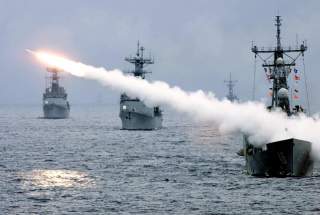Can This New Anti-Ship Missile Sink America's Enemies?
The Navy thinks so.
Key point: This missile is an important upgrade that will add to the Navy's capabilities.
The U.S. Navy in late January 2019 confirmed the designation of its newest cruise missile, in the process clarifying its long-term plan for arming its growing fleet of warships.
The plan heavily leans on one missile, in particular. It's the SM-6, an anti-aircraft weapon that quickly is evolving to perform almost every role the Navy assigns to a missile.
The Navy dubbed the newest version of the venerable Tomahawk cruise missile the "Block V" model, Jane's reported. There are two separate variants of the Block V missile, one with an anti-ship warhead and another with a warhead the Navy optimized for striking targets on land.
Raytheon's Tomahawk has been the subject of controversy in Washington, D.C. In order to save money the Obama administration wanted to pause production of the long-range missile, which since the 1980s has been the Navy's main weapon for striking land targets from the sea.
Congress overruled the Obama administration and continued buying Tomahawks for roughly $1 million apiece, adding potentially hundreds of the missiles to the thousands the fleet already possesses.
But it's the less-well-known SM-6, which also is a Raytheon product, that could dominate the Navy's planning. Of the 10 major missiles that arm the Navy's 285-and-growing surface ships and submarines, only the SM-6 is capable of striking targets at sea, in the air and at the edge of the atmosphere.
The Navy plans to buy 1,800 SM-6s through 2026 at a total cost of $6.4 billion. The missile arms certain destroyers and cruisers equipped with the Aegis radar system. As of late 2018 the U.S. fleet included 38 Aegis warships that are compatible with the missile-defense interceptors such as the SM-6. The Navy wants to grow that number to 41 in 2019.
Only the SM-6 can sink ships, shoot down planes and intercept ballistic missiles. And with a few modifications, the SM-6 also could target enemy ground forces and even submarines. "A single missile in a single launch tube could thereby provide the warfighter with a range of effects," missile-expert Thomas Karako wrote for the Washington, D.C.-based Center for Strategic and International Studies.
The SM-6 is a Frankenstein's monster that features components Raytheon borrowed from other missile types. It combines the seeker and blast warhead of an Advanced Medium-Range Air-to-Air Missile and the airframe of the Navy's older SM-2 surface-to-air missile.
When the SM-6 Block I first became operational in 2013, its main mission was shooting down aircraft and cruise missiles. "Additional capability was then added for terminal-phase intercept of ballistic missiles," Karako noted.
The Navy further tweaked the missile's sensor, producing the Block IA version. In a 2016 test, an SM-6 Block IA struck a target on the ocean's surface. Now the SM-6 also is an anti-ship missile.
The missile could continue to evolve. "Additional changes to the seeker and warhead could potentially add a land-attack mission to the SM-6," Karako pointed out.
According to Bryan Clark, a naval analyst with the Center for Strategic and Budgetary Assessments in Washington, D.C., the Navy also could produce an anti-submarine version of the missile by replacing the warhead with a torpedo that would detach from the rocket body, similar to what the sea service's defunct ASROC missile did during the Cold War.
There's just one mission an SM-6 cannot perform without radical modification. Missiles' seekers work differently in the air than they do in the vacuum of space. Air friction requires designers to add a cover atop the seeker of a missile that's supposed to function within the atmosphere.
The cover must be invisible to the weapon's sensor, a requirement that limits the variety of materials developers can use and, to a great extent, drives sensor design. Small tweaks can give a basic radar or infrared seeker the ability to home in on sea, land and air targets.
But targets in space -- such as ballistic missiles during their mid-course phase of flight -- fundamentally are different. They're cold, for one. Since there's no air friction in space, missiles' seekers can be open to the vacuum, giving developers more freedom to add infrared sensors that are optimized for detecting cold targets.
The open-versus-closed seeker dichotomy explains why the Navy uses closed-seeker SM-2s and SM-6s for interceptions in the atmosphere, and special, open-seeker SM-3s for interceptions above the atmosphere. Modifying an SM-6 to hit ballistic missiles in space pretty much would make it an SM-3.
While that distinction might seem semantic, it delineates the theoretical limits of the basic SM-6 design. Essentially, the SM-6 with just a few modifications can do practically everything but hit targets in space.
The Tomahawk and its controversies might make headlines, but as the U.S. Navy re-arms for high-tech warfare, the SM-6 is the missile to watch.
David Axe serves as the new Defense Editor of the National Interest. He is the author of the graphic novels War Fix, War Is Boring and Machete Squad. (This first appeared earlier in 2019.)
Image: Reuters.

